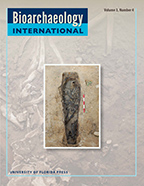“Captain of All These Men of Death”: An Integrated Case Study of Tuberculosis in Nineteenth-Century Otago, New Zealand
Main Article Content
Abstract
The South Island of New Zealand saw several major waves of migration in the mid-nineteenth century, predominantly from Europe but also with an ethnically distinct Chinese presence. The rural community of Milton, Otago, was a settler community established primarily by immigrants from the United Kingdom in search of a better quality of life. However, these settlers faced unique challenges related to surviving in an isolated location with very little infrastructure compared to their origin populations. In 2016, excavation was undertaken at St. John’s burial ground, Milton, with the object of using bioarchaeological methods to elucidate the lived experience of the first organized European settlement of this region, particularly in terms of health and disease. Here we present a case study of Burial 21 (B21), a male individual of known identity and a documented cause of death. We use biochemical and paleopathological methods to ground-truth his written history, which includes a period of invalidism due to tuberculosis, and discuss the implications of our findings for the community, provision of care, and quality of life in rural colonial New Zealand.
He maha tonu ngā hekenga tāngata ki Te Waka a Māui i ngā tau kei waenga pū o te rau tau 1800, ko te nuinga nō Ūropi, heoi he tokomaha tonu nō Haina. Nā ngā manene nō Peretānia te hapori o Milton i whakatū ki Tokomairaro, i Ōtākou, i tō rātou hiahia ki tētehi oranga kounga ake i tō rātou oranga i Peretānia. Heoi, ko ētehi o ngā wero nui i tau ki ngā manene nei i ahu mai i te noho pūreirei ki tētehi wāhi kāore rawa ngā ratonga i rite ki ngā wāhi i ahu mai ai rātou. I te tau 2016, i hahu kōiwi i te urupā o Hato Hone, i Milton, hei whakamātau i te kaha o te ora me ngā momo mate i pā atu ki ngā tāngata whai i noho i te rohe nei. Nei rā he ripoata mō tētehi kua hahua, kua tapaina ko B21, he tāne ia, ko tōna ingoa kua mōhiotia, ko tōna mate kua āta tuhia. Kua āta whakamātauria ōna kōiwi me ōna toenga kiko mō ngā tohu ora me ngā tohu mate, kia mārama ai mena rānei e hāngai ana ngā tuhinga rongoā mōna, ngā mea i tuhia nōna e takatū ana, tae atu ki te wā i tūroro ia i te mate kohi, ki ngā tohu e puta ana i te mātauranga Rongoā-Koiora ō nāianei. Ka matapakina ngā hīrautanga o ngā kitenga me te māramatanga kua puta i tēnei rangahau e pā ana ki te hapori, ki ngā ratonga hauora, me te kounga o te oranga mō te hunga noho tuawhenua i tērā wā i Aotearoa.

